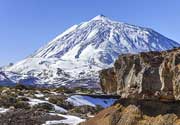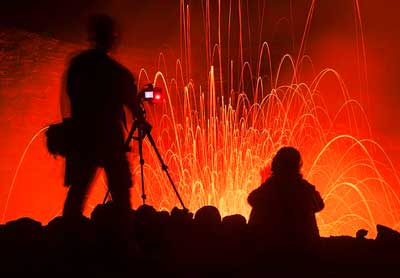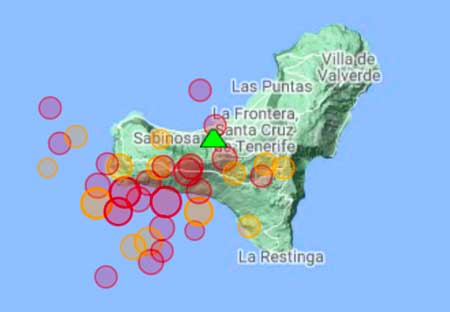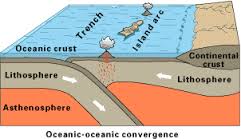-
Iamelele volcano (also called Iamalele or Iamalele-Fagululu) is a group of young lava domes and active thermal fields inland from Seymour Bay in the western part of Fergusson Island, in the center of the D'Entrecasteaux island group of Papua New Guinea.
The thermal areas near Iamelele village contain boiling springs, mud pools, and fumaroles. There are at least 6 fumarole fields on a SSE-NNW trending line of 6 km length.
Ibu
(Volcano)
-
Only a few eruptions have been recorded from Ibu in historical time, the first was a small explosive eruption from the summit crater in 1911. An eruption producing a lava dome that eventually covered much of the floor of the inner summit crater began in December 1998.
-
Ibusuki volcano is a group of calderas, central cones and maars at the southern tip of Kyushu Island, Japan. Although the last eruption dates back to the 9th century, it is an active volcano.
It contains the 4.5-km-wide Ikeda-ko caldera, which formed about 4600 years ago, and the andesitic Kaimon-dake stratovolcano, the most prominent feature of the volcano. Kaimon-dake contains a lava dome at the summit.
The Ibusuku volcano has been very active during the past 10,000 years. Since about 2650 years ago, all activity has taken place from Kaimon-dake, the last one in the 9th century.
Ijen
(Volcano: Kawah Ijen)
-
Volcano in East Java, famous for its acid crater lake and the rich sulphur deposits being quarried manually.
-
Ile des Cendres ("Island of Ashes") volcano is a group of submarine volcanoes off the SE coast of Vietnam. It consists of 2 submarine cinder cones that formed temporary islands during the last eruption in 1923 and 2 submarine lava cones of uncertain age. Several other submarine volcanic cones are found between the mainland of Vietnam and the Ile des Cendres.
A submarine eruption began on 2 March 1923 and produced 2 small islands, one about 30 m high and about 450 m long, and the other only 30 m wide and 30 cm high. A third submarine vent built a cone that reached to within 20 m of the surface. The islands were eroded after the eruption ended on 13 May, and are now submerged.
-
Iliamna volcano is a large stratovolcano on the western side of the Cook Inlet, in Lake Clark National Park 220 km SW of Anchorage or 100 km NW of Homer.
There are several uncertain reports about activity in the past 250 years, but the only confirmed known historical eruptions were small to moderate explosive eruptions in 1876, 1867, and between 778 and 1879. A larger eruption with pyroclastic flows was dated by radiocarbon method and occurred between 300 and 140 years ago, but was not observed. Most of the sparse eruption reports from Iliamna are probably referring to strong activity of fumaroles located east and SE of the summit.
-
Frequently active Iliboleng volcano (or Ili Boleng) is located in the SE corner of Adonara Island, across a narrow strait from Lomblen Island and 25 km east of Flores. Iliboleng has 5 partly overlapping summit craters and an irregular profile caused by lava flows.
A cone low on the SE flank, Balile, has also erupted lava flows. Historical eruptions were first recorded in 1885. Frequent eruptions since then consisted of moderate explosive activity. Lava flows were only observed in the eruption of 1888.
-
Ilikedeka is an eroded older and perhaps extinct volcano near Riang Kotang in eastern Flores, Indonesia. Two solfatara fields are located at the volcano, one near Riang Kotang village, extending over 50 m, and a second field 150 m further to the west. Hot springs are found on the beach of Hading Bay.
-
Ililabalekan is a steep stratovolcano on a prominent peninsula in SW Lembata (formerly Lomblen) Island. There are no known historic eruptions, but active fumaroles occure near the summit.
Ililabalekan volcano has a flank cone on the SE flank and 4 summit craters, one of which contains a lava dome and two small explosion pits.
-
Ilimuda volcano, located 6.5 km north of Lewotobi Lakilaki volcano opposite Konga Bay in eastern Flores, has a large 1 km wide and 450 m deep crater breached to the southeast. An active fumarole is found inside the NE crater rim.
A number of flank cones, including the Ilibotong lava dome, are located on the lower SE and NE flanks.
-
Illiniza is a glacier-covered stratovolcano 55 km southwest of Quito, Ecuador. It has 2 peaks 1.8 km apart, Illiniza Sur (5248 m) and Illiniza Norte (5126 m) and forms a prominent landmark west of the Interandean valley.
Iliniza Norte is the remnant of the older volcanic edifice, while Iliniza Sur is a younger stratovolcano of andesitic-dacitic composition. It contains a caldera filled by lava flows and domes and is surrounded by thick pyroclastic flow deposits. 2 lava domes are located on the southern and NE flanks of the complex.
Most activity of the heavily eroded Iliniza volcano took place before the Holocene, but the Tishigcuchi (Rasuyacu) lava dome on the southern flank was active during the past 10,000 years.
-
Iliwerung volcano forms a prominent south-facing peninsula on Lembata (Lomblen) Island and lies 80 km east of Flores. Its craters and lava domes have been built along N-S and NW-SE trend. In historical time both vents from the summit and submarine vents on the SE flank have been active.
-
Ilopango volcano is a 8x11 km wide caldera at the eastern margin of San Salvador city, El Salvador. It is elongated to the east, has 150-500 m high walls and contains the scenic Lake Ilopango, one of El Salvador's largest.
The caldera is the result of at least 4 large plinian eruptions over the past few tens of thousands years. The lastest of these occurred in the 5th centruy AD. A historic eruption in 1879-80 formed Islas Quemadas ("burnt islands"), a group of islands in the center of the lake, corresponding to the summit of a mostly submerged post-caldera lava dome.
-
Imbabura volcano in northern Ecuador is located above the scenic Laguna de San Pablo in the Interandean valley 60 km north of the capital Quito.
Eruptions at Imbabura volcano generated pyroclastic flows that extended northeast. A large dome collapse of Huarmi Imbabura about 8000 years ago generated a debris avalanche that caused a large seiche (tidal wave, tsunami) in San Pablo lake at the western base of Imbabura.
Historical activity consisted only in mudflows and rock slides, but the volcano is considered active.
Imun
(Volcano)
-
Imun is a single small dacitic and/or rhyolitic cone south of Lake Toba with a youthful, undissected morphology, and is considered to be of late-Pleistocene or Holocene age (Aldiss et al., 1983). Source: Smithsonian GVP
-
Indian Heaven volcano is a volcanic field 30 km halfway between Mt St. Helens and Mount Adams volcano, Washington, USA. It contains several low overlapping basaltic shield volcanoes and more than 50 flank vents with spatter cones primarily oriented along a N-S line.
The youngest eruption occurred only about 8,200 years ago and produced the voluminous Big Lava Bed, a 0.9 km3 basaltic lava flow that traveled nearly 25 km south from its source, an unnamed cinder cone SE of Red Mountain, to within 8 km of the Columbia River.
-
Infiernillo ("little hell") is a young basaltic-andesite volcanic field located along the Río Salado in Argentina about 70 km east of the crest of the Andes and NW of the town of Malargüe, 1000 km distance from Buenos Aires.
Volcanism in the field was caused by extensional tectonics resulting in fissure eruptions that produced lava flows that reached to the river. The last eruption occurred about 9000 years ago at the Volcán Hoyo Colorado vent.
-
Inielika volcano in central Flores is a broad, low volcano constructed within the Lobobutu caldera. It covers an area of 190 sq km. The first historical eruption of Inielika was a phreatic explosion that formed a new crater in 1905.
-
Gunung Inierie volcano is an impressive stratovolcano dominating south-central Flores and overlooking the Sawu Sea, and forms the highest peak of Flores. The unvegetated summit has a small steep-walled crater. No historic eruptions are known from the volcano, but there are sometimes reports of "smoke" visible from the crater, as in June 1911. There are hot springs on the northern flank of the volcano and geothermal areas to the east and NE.
-
Intraplate refers to the location of an event (e.g. an earthquake) in the interior of a tectonic plate.
-
Inyo Craters are a 12-km long field of lava domes at the eastern margin of the Sierra Nevada, California, near the town of Mammoth and south of the similar Mono Craters field. The field contains silicic 6 lava domes, lava flows, and 15 explosion craters (maars) that last erupted about 600 years ago.
-
Iraya is an active stratovolcano on Batan Island, 200 km north of Luzon, Philippines. It is the northernmost active volcano in the Philippines. Its last eruption probably happened in 1454 AD, but little details are known about this eruption.
It seems that Iraya volcano's eruptions were exclusively explosive, forming many pyroclastic flows. There are no lava flows.
In 1998, an earthquake swarm occurred beneath the volcano.
-
Costa Rica's highest volcano. It contains a green acid crater lake.
-
Mount Iriga volcano is a small stratovolcano immediately SW of Lake Buhi in southern Luzon, Philippines.
The volcano is dominantly andesitic in composition, but has several basaltic flank cones. It has a large crater breached to the SE, which formed during a massive flank failure that produced a large debris avalanche which buried several villages and formed a hilly, irregular deposit on the plain south of Lake Buhi 4 km from the summit.
-
Iriomote-jima volcano is a shallow submarine volcano 25 km NNE of the island of the same name.
Iriomote-jima island is the southernmost in the chain of the Ryuku Islands which still belong to Japan. It is located almost 1000 km SSW of Japan's main island Honshu and only 200 km east of Taiwan.
-
Irruputuncu is a small stratovolcano in northern Chile on the border with Bolivia. It contains 2 summit craters. A small summit lava dome and fumarolic activity are found at the southern crater which measures about 300 m in diameter.
-
Isarog volcano is an andesitic stratovolcano of Naga city, in SE Luzon, Philippines. It is part of the Bicol volcanic chain, and could still be active although no historic eruptions are known. The volcano has active fumaroles, steam vents and hot springs.
-
The Ischia volcanic complex forms a rectangular, 6 x 9 km island immediately SW of the Campi Flegrei area at the western side of the Bay of Naples.
-
A field of 8 cinder cones near the Iskut-Unuk River in NW British Columbia, Canada, is located at the southern end of the Stikine volcanic belt.
-
Isla El Tigre volcano is a small basaltic stratovolcano that forms the small, 5-km-wide island of the same name. It is located across a narrow 2-km-wide strait south of Isla Zacate Grande in the Gulf of Fonseca, Honduras. It is the southernmost volcano of Honduras and probably still active.
El Vigía is a small isolated flank cone near the village of Amapala on the NW flank of the island.
-
Isla San Luis volcano forms the largest of the 7 Encantada islands in the northern part of the Gulf of California, about 3 km offshore. It is 4.5 sq km large and consists of a 180 m high cone with a narrow peninsula on the SW end.
It is not known when the volcano last erupted, but it could have been less than 100 years ago.
-
Isla Tortuga volcano is a young basaltic shield volcano that forms the small 4 km wide island of the same name located 40 km off the Baja coast in the Gulf of California.
The volcano has a circular summit caldera, about 100 m deep, containing a frozen lava and several cinder cones from probably relatively recent eruptions. Young lava flows cover most of the volcano's flanks. At present, there is fumarolic activity.
-
Isla Zacate volcano (or Isla Zacate Grande) is a stratovolcano that forms a low 7 x 10 km wide island in southern Honduras separated by a narrow strait from and surrounded by the Gulf of Fonseca and Chismuyo Bay.
The mainly basaltic volcano is strongly eroded with deep erosion valleys on the summit cone, suggesting it has not erupted for a long time.
-
Volcán Isluga volcano is a broad stratovolcano in northern Chile 7 km west of the Bolivian border and forms the western end of a group of volcanoes extending to Tata Sabaya volcano in Bolivia. Isluga volcano is part of the 175,000 hectares Isluga National Park.
Isluga's summit contains a morphologically young, 400 m wide crater at the western end of the elongated, snow-covered summit region. Many lava flows with distinct levees can be seen on the southern flank and in 1878, lava flows destroyed several towns. At present, there is fumarolic activity at Isluga volcano, the last confirmed eruption was a small explosive eruption in 1913.
Ivao
(Volcano)
-
Ivao volcano is a group of several cinder cones on Urup Island, Kurile Islands. The cones are aligned NW-SE along the Krishtofovich Ridge of SW Urup Island.
The Ivao group itself consists of 3 young cones that are less than 10,000 years old. Ivao cone at the NW end is the highest of the group and the highest peak on Urup Island.
Lake Ivao has formed as a result of damming of a valley by the SE-most cone. Krutaya Mountain is the elongated central cone. It is the vent of the most recent eruption which erupted a viscous lava flow to the east.
(Source: GVP / Smithsonian volcano information)
-
Iwaki (or Iwakisan) volcano is a large symmetrical stratovolcano and the NW-most active volcano in Honshu, Japan. Because of its shape, it has been called the Fuji-san of the Tsugaru district.
Iwaki contains a 2-km-wide summit crater which is filled by a lava dome flanked by 6explosion craters. 3 lava domes are found on the western and southern flanks of the andesitic volcano. Historical eruptions have been reported at Iwaki since 1600 AD and have consisted primarily of small-to-moderate phreatic explosions.
-
Iwate (or Iwatesan) volcano is a symmetrical stratovolcano in northern Honshu, Japan, 20 km northwest of Morioka City.
It consists of 2 cones, the older western Nishi-Iwate and the younger eastern summit Higashi-Iwate. The older volcano to the west is truncated by a caldera that resulted from repeated collapse.
The caldera contains a central cone with a 500 m wide crater containing a lake and is breached by a narrow gorge to the NW.
Volcanic activity migrated to the east and built Yakushi-dake, the young, mainly basaltic summit cone of Higashi-Iwate. Yakushi-dake contains a 500 m wide crater and partly buries the eastern rim of the caldera. It is the vent of most recent activity including a lava flow from the eruption in 1732 that traveled down the NE flank.
The last historic activity was a small phreatic eruption from O-jigokudani on the W side of the Onigajo caldera. The eruption caused mudflows.
There are uncertain reports about activity in July 1934.
-
Ioto (硫黄島, also known as Iwo-jima) volcano is a triangular-shaped, flat, 8 km long and up to 4.5 wide volcanic island stretching NE-SW. It is surrounded by steep cliffs under the sea, which belong to a 9-km-wide submarine caldera. The volcano is located 1250 km south of Tokyo in the central Volcano Islands of the Izu-Marianas arc.
The summit of Iwo-jima is Suribachi-yama at 160 m.
Parts of the caldera have been experiencing remarkably strong uplift (up to more than 1 meter per year and averaging 25 cm / year over several centuries). There is strong hydrothermal activity at present, at fumaroles along a NE-SW zone cutting through Moto-yama. Many phreatic eruptions occurred in historic times, mostly from vents on the west and NW sides of the island.
Iwo-jima was the site of an infamous WWII battle, and the location of a famous image of the raised US flag.
-
Io-Torishima (also known as Iwo-Torishima or Okinawa-Torishima) volcano forms a small 1x2,7 km island located north of the largest island of the Ryukyus, Okinawa.
Records of historical eruptions dating back to 1664 have consisted of mild-to-moderate explosive activity. Iwo-dake, the volcano forming the NW part of the island, has a small lake, solfataras, and sulfur deposits that were mined in the past.
The name part Tori-shima ("Bird Island") is common for small offshore islands in Japan.
Iya
(Volcano)
-
Iya volcano in central Flores is the southernmost of a group of 3 volcanoes (Iya, Rooia and Pui) forming a small peninsula south of the city of Ende. Rooja and Pui cones to the north appear to be older than Iya and have no known historic activity.
Many small eruptions have occurred at Iya volcano in historic times.
-
Iyang-Argapura twin volcano is a massive complex in East Java, Indonesia, 25 km NW of the university town of Jember. It dominates the landscape between Raung and Lamongan volcanoes.
It is still considered active, although no eruptions seem to have occurred within the past 500 years at least, and the volcanic complex shows signs of heavy erosion.
Steep valleys and erosion cliffs of up to 1000 m depth cut the base of the older Iyang volcano. The volcano's construction followed a N-S rift-like trend, with overlapping craters and cones forming on this line.
At present, there are only fumaroles in Iyang crater as sign of activity. Uncertain reports might indicate an eruption 1597.
-
Izalco volcano was born in 1770 and is the youngest volcano in El Slavador. It formed on the southern flank of Santa Ana volcano located 45 km NW of San Salvador city.
Frequent strombolian eruptions and sometimes lava flows have built a largely unvegetated cone 650 m high which contains a 250 m wide and 50 m deep summit crater.
Volcán Izalco was frequently active between 1770 and 1966, but has been in its longest repose interval of its short history since then.
Similarly to
Stromboli volcano in Italy, it acquired the nickname of "El Faro", the "Lighthouse of the Pacific", because of its frequent strombolian eruptions that provided a natural night-time beacon beacon for ships.
Izalco is one of the most frequently active volcanoes in North and Central America.
-
Iztaccíhuatl volcano (also spelled Ixtaccíhuatl) is a massive andesitic stratovolcano next to the famous neighbor Popocatépetl volcano. It is the 3rd highest mountain of Mexico.
Iztaccíhuatl has the profile of a sleeping woman when seen from the Valley of Mexico, which gave it its name meaning "Woman in White", referring also to the Ayoloco glacier covering its summit. Geologically, it is the predecessor volcano of Popocatépetl and now in its final stages of infrequent activity, with some activity sometime less than 11,000 years ago.
-
Izu-Tobu volcano is a group of volcanic vents with cinder cones, lava flows, domes and tephra deposits on the NE Izu peninsula 80 km SW of Tokyo.
The Izu-Tobu volcanic group covers an area of 400 sq km and contains many submarine volcanoes offshore of the peninsula. Most of its erupted magmas are basalt, and a smaller volume is andesite.
Ito city is the largest town (ca. 70,000 inhabitants) located in the volcanic field. It is known for its hot springs and resorts.
The latest eruption of Izu-Tobu volcano was in 1989, when a small submarine crater formed NE of Ito City.



